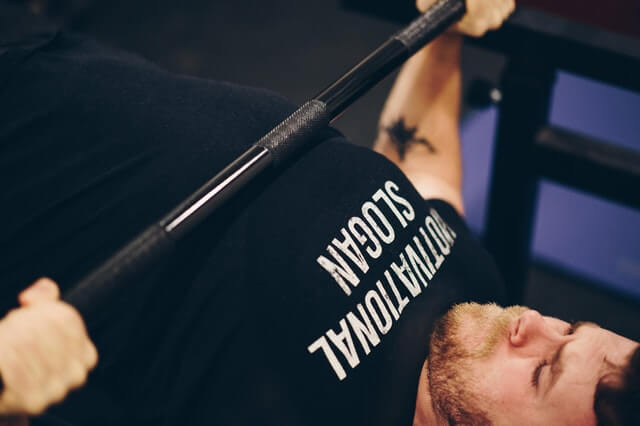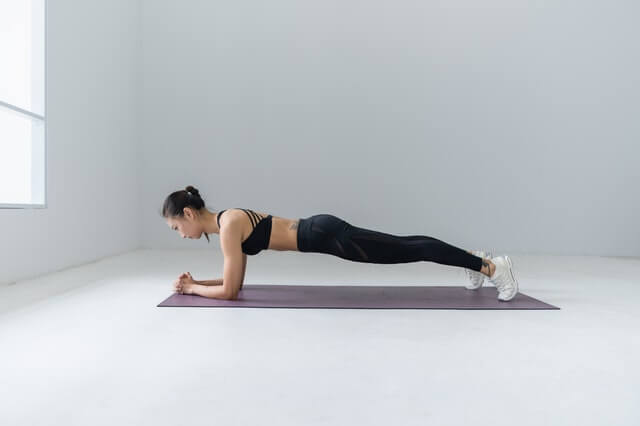Do you also dream of a muscular body with defined upper arms, pronounced shoulders and strong thighs? Then you are not alone. However, the path to your dream body can only be achieved through effective and, above all, targeted training.
If you just “ train straight away ” without a training plan , you won’t achieve much in terms of muscle growth . Find out what is really important for a long-term successful training concept and start your dream body project today!
Training plans: How you can build mass sustainably
Our body consists of around 650 muscles that control our movements and give our body its visual shape. The distribution and shape of the muscles alone, together with the body fat percentage, determine whether we look athletic or flabby.
Fortunately, you don't have to train all the muscles individually. Many of these muscles are small muscles that are trained during targeted movements anyway. Others, on the other hand, sit in our face and don't need any training at all.
The most important functional human muscle groups for muscle building training are:
- Back muscles
- Leg muscles (including gluteal muscles)
- Leg muscles (upper and lower leg)
- Arm muscles (including shoulder)
- Chest muscles
- abdominal muscles
Muscle building training is specifically about these muscle groups - by covering them with specific exercises.
Important: Basically, it is of secondary importance which training structure you choose. What is much more important is that you train correctly. This is the only way to achieve optimal muscle growth .

Muscles only grow with supra-threshold training stimuli
Our muscles only grow when they have to. When training, you have to signal to your body that it is reaching its limits in its current state. He reacts to this borderline experience with the command to build muscles .
If you don't reach this threshold during training, there will be no muscle gain. Muscles can be trained in three areas. These are the maximum strength range, the strength endurance range and the so-called hypertrophy range .
While strength endurance training is about moving as high a load as possible a few times, strength endurance training aims to increase muscular endurance.
This is an advantage, for example, if you work in the trades and move low to moderate loads all day long. In the hypertrophy area, however, it is primarily about optimal muscle growth .
In order not to draw any false conclusions: the body builds muscles in all three training areas. However, it reaches its optimum in the so-called hypertrophy range. This is roughly in the range of 6 to 12 repetitions.
What does hypertrophy mean?
The term comes from Latin and in the medical sense means something like increase in size . In muscles, hypertrophy involves an increase in the contractile units within a muscle cell.
This results in an increase in the thickness of the muscle fibers , which means that the overall muscle increases in volume.
In contrast, there is hyperplasia, where the number of muscle cells increases. According to current scientific findings, hyperplasia does not play a significant role in building muscle, at least in humans. However, there are studies that give an indication of a possible influence.
Muscle building training plan: 7 tips for optimal muscle growth
To get the most out of your plan, there are a few rules you need to follow. These golden rules apply to all exercises you perform and are even more important than exercise selection itself.
1. Training intensity
In order for the muscles to reach their limits , you have to subject them to intense stress. The optimal level of thickness growth (hypertrophy) is reached at 60 to 80 percent of maximum strength.
For example, if you can do a single squat with 100 kilograms, your optimal training weight is currently 60 to 80 kilograms. Attention: You should only carry out such a maximum strength test under the supervision of a trainer or training partner.
2. Rep range
The repetition range for the most efficient muscle building is between 6 and 12 repetitions per set. It is important that each repetition is carried out absolutely cleanly and in a controlled manner.
In return, this doesn't mean that you won't build muscle with 5 or 14 repetitions. Hypertrophy training is only intended as a guide for your training planning. Three to four sets per exercise is a good guideline.
Attention: Warm up to get your muscles up to temperature before the first set of work and to avoid injuries. Start with 10 minutes on the treadmill or exercise bike. Then perform one or two warm-up sets with a low weight for each exercise for a new muscle group.
3. Load duration (TuT)
The time in which the muscles are under tension is crucial for setting the growth stimulus. Here we are talking about “ Time under Tension ” (TuT for short). The following applies : the longer the muscles are under tension, the higher the growth stimulus.
Each repetition is divided into three sub-movements:
- Lifting the load (concentric phase)
- Holding the load (static phase)
- Lowering the load (eccentric phase)
Ideally, the concentric phase lasts 1 to 2 seconds. Then hold the weight at the top briefly for a second. Then go into the eccentric phase and lower the weight for 3 to 4 seconds. Many strength sports people neglect the eccentric phase in particular.
Instead of actively using them, they let the weight fall more or less. This is a big mistake, because eccentric loading has great potential for building muscle . This is proven by numerous studies, including a study by the Heidelberg University Hospital from 2007.
4. Sentence breaks
In order for the muscles to recover between sets, the break must be long enough. But it shouldn't be too long either. The latter would unnecessarily reduce the training intensity . Depending on the exercise, a 60 to 120 second set break is ideal.
As a rule of thumb, remember:
The larger the proportion of body muscles involved in an exercise, the longer the break between sentences can last.
While the ideal time for bicep curls is 60 seconds, you can increase it to 90 seconds for the bench press. After all, several muscles work together here: the chest, shoulders and triceps.
Long rest periods of 120 seconds are ideal for heavy exercises with high overall muscle recruitment such as deadlifts or squats.

5. Training Frequency & Recovery
A muscle does not grow during exercise, but rather during the recovery phase . Therefore, give your muscles enough time to regenerate after training. Only when the damage caused by training is repaired can the muscle grow and reach a new level of performance.
Before training the same muscle again, you should rest for 48 to 72 hours. After a particularly hard workout, the recovery time can take longer.
In order to optimally exploit the effect of supercompensation for rapid muscle building when it comes to training frequency, train each muscle group at best two to a maximum of three times per week.
For beginners, a full-body training plan completed three times a week is absolutely sufficient. Experienced athletes can switch to split training plans, where different parts of the body are trained on different days. Then five to a maximum of six training sessions per week are possible.
6. Regular increase
In order to grow muscle , you have to present your body with ever greater challenges. As muscle performance increases, the training load must also increase. And at best with every unit. The increase does not have to be large, but it should be measurable. A good indicator is the " total mass " you moved during exercise.
You can easily calculate this by multiplying the training weight by the number of repetitions and sets per exercise. For example, increase the weight if you reach the specified number of repetitions of 12 in the third set of an exercise.
Alternatively, you can complete a few additional reps on a particular exercise to increase the “ total mass ” moved. This principle is called “ progressive overload ” and ensures that the growth stimulus is maintained .

7. Record progress
Even the best plan is of little use if you don't keep records of your training weights, sets and reps. Therefore, get a small training diary so that you can record the most important key points during training.
This is the only way the performance can be compared and performance improvements can be used optimally for building muscles. As an alternative to the classic notepad, the app stores now offer a sufficient number of useful training apps .
Example: Muscle building training plan
If you want to gain mass , you can find tons of workout plans online. Most of these plans are split training plans, where different body parts are trained on different days.
However, these concepts are not necessarily suitable, especially for beginners or amateur athletes who just want to build a few muscles. It is ideal to start with a so-called whole-body training plan (GKP). You train your entire body three times a week.
Such a plan could look like this:
- Squats (3 x 6 to 12 reps)
- Deadlift (3 x 6 to 12 reps)
- Push-ups (3 x 15 to 12 reps)
- Bent-over barbell row with overhand grip (3 x 6 to 12 reps)
- Barbell bench press (3 x 6 to 12 reps)
- Standing Arnold press (3 x 6 to 12 reps)
- Tricep kickbacks with dumbbells (3 x 6 to 12 reps)
- Hammer curls (3 x 6 to 12 reps)
- Planks (forearm support, 3 reps)

Attention: Before you put together your own muscle building training plan!
The mentioned workout plan for more muscle mass is just an example of what a muscle building workout using only free weights could look like. When making the selection, however, we made sure that, with the exception of the triceps kickbacks and the hammer curls, as many muscle groups as possible were always active at the same time.
In addition, the order of the exercises follows a fixed pattern : first large muscle groups, then small muscle groups. Please pay attention to this scheme when putting together your training plan.
It doesn't matter whether you put together a workout plan consisting of dumbbell exercises, machine exercises or exercises with your own body weight (bodyweight exercises).
Unfortunately, we cannot give you a general answer as to which exercises are best for building muscles. Every body is different in this respect.
Feel free to try out which exercises you feel most comfortable with under the supervision of a trainer . You can always switch between exercises later.
Attention : technique before weight!
Before you lift heavy weights, you must first learn the correct technique. Only when your muscles and nerves work together optimally can your body carry out the movement safely.
This is especially true for complex multi-joint exercises such as squats, deadlifts or bench presses. Start with a light weight and high reps. Later you will be able to move heavy weights safely and with little risk of injury.
Simple nutrition plan: What is good for building muscle?
If you want to build muscle mass , you have to train sufficiently intensively and often. But this is only half the truth. You can achieve up to 70 percent of your success in the kitchen.
How does proper nutrition work?
We'll explain to you what's actually important in a nutrition plan for building muscle .

A training plan for building muscle requires a calorie surplus
In order to be able to build muscle, your body needs fuel and building materials. After all, your goal is to build additional tissue. If you eat too little and the wrong foods, your body will lack both. If you want to build muscle in the long term , you need a moderate calorie surplus.
Only when additional energy is available does our body even think about building muscle. This is because our organism is still stuck in the past in terms of evolution and is therefore strongly geared towards efficiency.
In short: He normally does not consume any “ unnecessary ” energy that he does not need.
Therefore, in addition to the training stimulus, sufficient nutrient intake is also important for building muscles . In fact, it's not the sheer quantity that matters, but rather the quality.
You can create a perfect foundation with the following rules:
- Plan on a daily calorie surplus of 300 to 500 kcal.
- Eat a diet rich in protein and from a variety of protein sources.
- Make sure you eat a wholesome diet with lots of whole grains, fruits and vegetables.
- Consume enough healthy fats (e.g. nuts, flax seeds, sea fish, etc.).
- Cook fresh and avoid ready-made products.
- Drink around 30 - 40 milliliters of water per kilogram of body weight every day (2 - 3 liters per day).
- After exercise, eat a meal rich in protein and carbohydrates.
Dietary supplements from amino acids to zinc
When it comes to muscle gain, we quickly come to the topic of nutritional supplements . From creatine and salmon oil to training boosters and individual amino acids such as beta-alanine and zinc, nothing is left to be desired.
The truth is that a balanced diet eliminates the need for many nutritional supplements for most athletes.
However, deficiencies in nutrition and intake often arise, especially in the area of proteins and amino acids . Many athletes find it difficult to meet the need for proteins and essential amino acids , which is increased by sport.
For optimal mass building , the guideline value is approx. 1.5 to 1.8 grams per kilogram of body weight per day.
This gap can be closed by supplying high-quality amino acids . Important: Dietary supplements in general and protein preparations or amino acids are not a substitute for a balanced diet in sport. They are a supplement that help achieve the goal and optimize the result.

FAQ - Frequently asked questions about hypertrophy training
For most people, losing weight and building muscle at the same time doesn't work. This is because the body needs a calorie deficit to lose body fat and a calorie surplus to build muscle .
This phenomenon is only possible for people who are picking up a weight for the first time in their lives. However, this phase is only very short. It is also possible for athletes who return to the iron after a long period of abstinence.
The so-called “ muscle memory effect ” helps you return to your existing muscle mass more quickly.
But here too the period is very limited. However, the bottom line is that in most cases, significant mass gain with simultaneous fat loss is not possible.
The myth of the bulking phase still haunts the fitness world. The mass phase classically means simply eating a lot over a period of several months (usually in winter) and gaining a lot of muscle through training .
Since the calorie surplus here is usually extremely high and the quality of the food is not always optimal, a lot of fat accumulates. This has to be laboriously trained off again in the spring.
We would therefore not recommend a classic “ bulk phase ” to anyone. And it is certainly not necessary to build muscles. It's better to maintain a slight calorie surplus of 300 to 500 kcal over the long term.
This way you put on as little body fat as possible at the same time.
You can also lose weight through strength training . Especially when you train large muscle groups such as the back or legs, the body burns a lot of calories. A really intensive strength training session costs up to 500 kcal per hour.
Realistically, energy consumption during an average workout is between 200 and 300 kcal per hour. In order to increase energy consumption and lose weight even more effectively, regular endurance training is particularly important.
By the way, your heart and your general fitness level will thank you.
Not everything that is possible is also sensible. After all, sore muscles are a muscle injury consciously caused by training. Therefore, it is best to stick to rest periods before training a muscle again.
Training with mild muscle soreness is okay in exceptional cases. However, if you have severe muscle soreness, you should rest the irons. If you train too early, you will interrupt the body's regeneration process.
This is counterproductive in terms of your performance and muscle building . Alternatively, if you have acute muscle soreness, include a cardio session on the bike or treadmill as active recovery in your training plan.
It's fun, accelerates regeneration and ensures that your muscles have even better blood flow for the next session.




